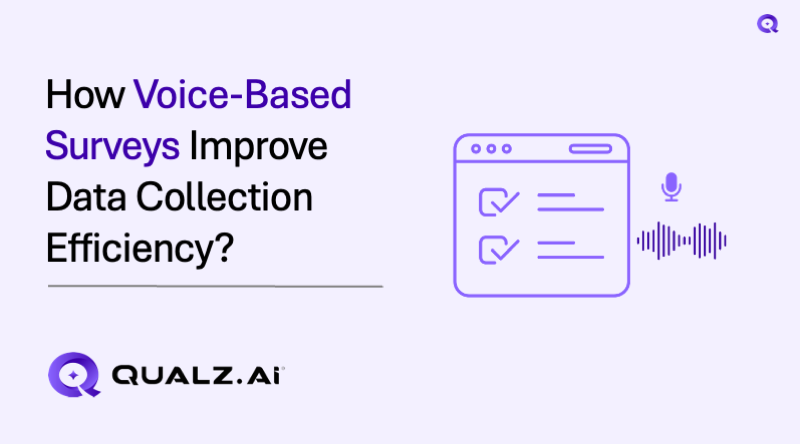Traditional survey methods, such as paper-based questionnaires, online forms, or email polls, have long served researchers, marketers, and product teams. While these methods have proven effective earlier, they are increasingly falling short in today’s fast-paced, mobile-first world. Respondents are busier, more distracted, and more reluctant to engage with lengthy or repetitive surveys. As a result, researchers and organizations often face low response rates, incomplete data, and longer turnaround times.
In this context, voice-based surveys offer a compelling alternative. By using spoken interaction via phone, mobile apps, or embedded voice bots, researchers can unlock more natural, rapid, and inclusive feedback collection. But their advantages go beyond convenience. Voice-based surveys improve data collection efficiency, inclusivity, emotional richness, and real-time responsiveness, all while reducing survey fatigue.
Topics Covered
ToggleThis blog explores what makes voice surveys powerful and how and why voice surveys significantly improve data collection efficiency, making them an essential tool for modern researchers and organizations alike.
What Are Voice-Based Surveys?
Voice-based surveys use spoken conversation, either with a human interviewer or a voice-enabled system, to collect survey data from participants. These surveys can be delivered through various channels:
- Phone calls (live or automated)
- Through AI voice assistants
- Mobile apps with built-in voice assistants
- Web-based surveys using microphone input/AI
At the heart of these systems are three core technologies:
- ASR (Automatic Speech Recognition): Converts spoken words into text.
- NLP (Natural Language Processing): Understands the meaning and context of responses to interpret meaning, extract insights, and classify sentiment
- TTS (Text-to-Speech): Allows the system to “speak” questions to the respondent.
Voice-based surveys can be synchronous (live interviews or real-time voice bots) or asynchronous (pre-recorded questions with user responses captured for later analysis). Either way, they offer a natural, human-like interaction model that removes the friction commonly found in traditional surveys.
Key Benefits of Voice-Based Surveys for Data Collection Efficiency
Faster Response Collection
One of the most immediate benefits of voice-based surveys is speed. Speaking is faster than typing. Most people talk at a rate of 125–150 words per minute, compared to typing at 40–60 words per minute. When participants can simply speak their responses, the overall time required to complete a survey drops dramatically.
In addition, voice surveys can guide respondents through the flow more naturally, reducing drop-off rates. Unlike written surveys, where a participant might pause, skim, or get distracted, voice interactions create a conversational rhythm that keeps the process moving. This speed is especially valuable in:
- In-the-moment feedback (e.g., after using a product)
- Field studies or rural research with limited digital interfaces
- Scenarios where time is critical (e.g., hospital checkouts, in-transit travelers)
Higher Response Rates
Voice-based surveys are more convenient and engaging, often leading to higher participation. Participants can complete surveys while walking or driving, which wouldn’t accommodate typing or reading.
This hands-free, frictionless experience:
- Reduces drop-off
- Encourages participation from busy or hard-to-reach audiences
- Boosts longitudinal engagement
Broader Reach and Accessibility
Voice surveys are inherently more inclusive. They provide a valuable option for individuals who:
- Struggle with reading or writing (due to literacy or disabilities)
- Multilingual speakers through real-time translation
- Visually impaired users
- Have limited access to screens or keyboards
- Participants are more comfortable with conversation than with typing
Richer, Unstructured Data
Voice doesn’t just capture what people say; it also captures how they say it.
Voice-based formats encourage open-ended responses. Participants are more likely to elaborate when speaking than typing, leading to richer qualitative data.
Moreover, voice responses often carry emotional and tonal cues that written responses lack. These nuances can provide additional layers of insight, such as stress, enthusiasm, or uncertainty. With the help of voice-based surveys, researchers can extract emotional depth and detect insights that traditional surveys miss.
Reduction in Survey Fatigue
Participants often abandon long, repetitive surveys. Voice interactions feel more like natural conversations and are less cognitively taxing. They
- Mimic real dialogue, increasing flow
- Feel personal and adaptive
Traditional surveys often feel like a chore, especially when long, repetitive, or poorly designed. Voice-based surveys flip the experience by making it feel like a natural conversation.
This conversational flow reduces cognitive load and keeps participants more engaged. Well-designed voice surveys can adapt in real-time based on previous answers, creating a personalized experience that feels more human and less mechanical. The result? Fewer incomplete responses, less fatigue, and more accurate data were collected in a fraction of the time.
Why Voice-Based Surveys Are the Future of Research
Voice technology is transforming qualitative data collection by conducting research:
- Faster
- More inclusive
- Emotionally nuanced
- Adaptive to real-world constraints
Platforms like Qualz.ai lead the way by combining voice input, real-time AI moderation, and robust analytics in one unified ecosystem. You can also upload existing voice data and receive structured, coded analysis within minutes. Sign up for free to explore the Qualz.ai Dynamic Survey!
Conclusion
Voice-based surveys represent more than a convenience; they are a paradigm shift in how we collect, understand, and act on data. By tapping into the most natural human interface, voice-based surveys dramatically reduce friction, speed up response times, and unlock richer, more inclusive insights.
Whether you’re a market researcher, academic, non-profit researcher, or independent researcher, voice-based surveys offer a smarter, faster, and more human way to collect data. As technology becomes more accessible and affordable, now is the time to pilot or adopt voice-first methods in your research toolkit.
